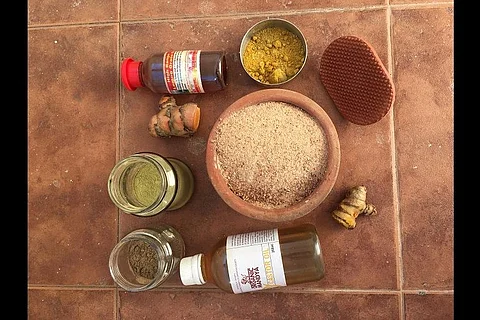

Deepa Harishankar
You spend your 20s with new found financial freedom and go bonkers on shampoos, lotions, soaps and other bathroom cabinet paraphernalia. When you enter your 30s, you realise that there is no solution which comes in a bottle to your bad hair issues. There is no magic shower gel that removes your blemishes.
And then, you find time to look into the ingredients that go into making these products. The most ‘natural’ products advertised on TV and via email have a dozen unpronounceable, complex chemical names. You have no idea if they do you any good. You are a little paranoid about what synthetically produced chemicals do to your body. Once they leave your bathroom drain, they enter the environment.
Sodium Lauryl Sulphate, which helps produce lather, can strip your hair of all natural oil. Formaldehyde, a preservative used in hair care products is a known animal carcinogen. When you start reading what’s written on the bottles of these skin and hair care products, you start searching for natural, harmless and healthier alternatives.
The humble soapnut and wild turmeric seem inviting now. There are several organic stores mushrooming all over our cities. Online stories aggressively market purely natural, organically grown seeyakkai(Acacia concinna), arappu/usilam podi, boondhikottai/ritha (soapnut) and nellimulli/amla soaps and shampoos for staggering prices.
But when our grandmothers did not spend so much on soap and shampoo, why must we? It's time to explore the "naatu marundhu kadai" or the little shops that sell native medicine in our neighborhoods.
It’s like a world of its own. There’s vetiver, black cumin, kasturi manjal, several other tubers, rhizomes and dried flowers that smell heavenly. It all feels like home. What’s more? After buying a year’s supply, you are poorer by a mere 300 rupees.
Making your own hair wash is very easy, effective and super cheap. And you also find assurance in the fact that you minimise environmental harm. Buy seeyakkai (shikakai) and dry it under the sun, along with whole green gram. For a hair wash that smells like a luxurious Ayurvedic spa ingredient, add dried lemon rinds, hibiscus flowers and rose petals.
To make sure your hair wash mixture stays free of infestation, add vasambu (sweet flag herb). Now, once the ingredients are dried to a crisp, get it ground in the flour mill nearby. Use this powder to wash your hair after a generous application of coconut oil.
If you find the smell of seeyakkai to be very strong, you can use arappu instead. Arappu is the leaf of the usilam tree. It does a decent job of cleaning your hair while being nice to your olfactory senses.
For optimum results, you can mix usilam podi and seeyakkai to wash your hair. Your hair feels heavenly after oiling and washing it, grandmom’s way.
Dry the green gram, kasturi manjal (wild turmeric), vetiver, lemon rinds, black cumin, marukozhundhu, neem leaves, sandalwood under the sun. Get it milled and store it in the fridge. Otherwise, the powder will get infested.
This makes an excellent body wash powder. Revel in a weekend of spa-ing in your own bathroom. Who needs perfume and deodorant when you smell like a queen getting out of her royal bath?
Amirtha, a grandmother from Chennai started making her 'snaana podi' and hair wash powders and other DIY cleaning powders when her granddaughter was born. She just continued with these powders, especially because she redirected bath water to her home garden and she felt it was detrimental for her plants to consume detergent and shampoo.
Ahalya Natarajan, an IT professional, has recently stopped using face wash, something she bought by the dozen until recently. She swears by the Oil Cleansing method. All she needs today is the humble castor oil or safflower oil.
She says, "Apart from giving me that glow and killing acne, it uses commonly available oil and is environment friendly. I have stopped using chemicals on my facial skin. Fancy exfoliating microbeads in a modern day facewash are actually tiny plastic beads that are too small to be filtered by the sewerage department and directly flow out to the sea. They remain in the sea forever. OCM, reusable menstrual cups and natural shampoos and conditioners are some ways of giving back to the environment."
Khader who runs a native medicine shop in Chennai says he has his own clientele that still makes hair wash powders for their entire families. He believes that commercially available shampoo users will someday return to the humble seeyakkai.
In Bengaluru, where coconut oil remains solid most days of the year, it is easy to make your own tooth paste. All it takes is coconut oil, baking soda and some peppermint oil.
DIY toiletry is not just about avoiding chemicals that might harm you and the environment. You save a lot of money and more importantly, you avoid piling up waste.
Those Body Shop bottles do say they are made of recyclable plastic. But, if you can do away with them altogether, isn’t that a better idea? Think of all the shampoo and shower gel bottles, sachets and packaging material involved with every single purchase.
Today, we are looking to reduce waste and the DIY culture will definitely help with the effort. The environmentally conscious folk even use soap nut to wash clothes.
Lemon grass oil, a spoonful of salt and a bucket of water can replace the detergent laden floor cleaning liquids we have become used to. Our environment can do with a little help from us.